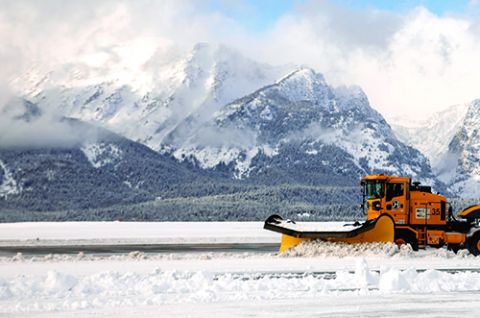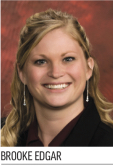Small Airports Share Tips About Buying Multifunction Snow Equipment

Small airports in the northern U.S. share one common trait with huge airports such as Chicago O’Hare and Kennedy International in New York: They have to keep their runways and taxiways clear of snow during winter.
Most, however, don’t have multimillion-dollar budgets for accomplishing this. The two small airports featured in this article manage to operate high-ticket multifunction machines. Here’s how they afford them.
Funding Finesse
Aberdeen Regional Airport (ABR) in South Dakota logs about 69,000 annual operations. In addition to serving an active general aviation community, it has two commercial carriers: SkyWest and Sun Country. “We only have one main runway (6,900 feet) and a crosswind runway (5,500 feet); so our customers really depend on us to keep the runways and taxiways open,” states Transportation Director Rich Krokel.
|
Project: Acquiring Multifunction Snow Removal Machines Location: Aberdeen (SD) Regional Airport Annual Operations: 69,000 Average Annual Snowfall: 38-40 inches 2018/2019 Snowfall: 80 inches Main Runway: 6,900 ft. Crosswind Runway: 5,500 ft. Equipment Purchased: MB5 Manufacturer: M-B Companies Cost: $1.5 million (2 full machines) Engineering Consultant: Helms & Associates Funding: 90% FAA Airport Improvement Program grant; 5% state; 5% city Delivery: Dec. 2017 Location: Jackson Hole (WY) Airport Annual Operations: 27,000 Average Annual Snowfall: 150-175 inches Main Runway Length: 6,300 ft. Equipment Purchased: RS400s Manufacturer: Overaasen Distributor: Myslik Inc. Cost: $1.05 million (3 sweepers without cabs) Funding: Airport capital improvement funds Deliveries: 2016, 2017, 2018 Key Benefits: Lower maintenance costs; faster runway clearing |
Unfortunately, ABR’s aging equipment made snow removal increasingly difficult. “We were using two plow trucks that were roughly 20 years old, and our broom was at least 10 years old,” explains Mark Hanley, the airport’s operations and maintenance manager. “We were getting more and more mechanical breakdowns that extended runway closures.”

Obtaining new snow removal equipment became a priority. After researching multiple options, Krokel and Hanley decided ABR needed a multifunction machine with a plow, broom and air blower, all in one chassis. They began the search process by meeting with a few equipment manufacturers to learn about their options and get help developing specifications for a new machine. They also enlisted the help of local engineering consultant Helms and Associates, which has a five-year contract with the airport for construction projects. Brooke Edgar, a project engineer with the company, helped ABR finalize its official request for proposals. From the submitted bids, airport officials decided to purchase two MB5 multifunction rigs, built by M-B Companies in Chilton, WI. The mammoth machines cost $750,000 each.
The next step was applying for FAA Airport Improvement Program (AIP) funding. Edgar spent many hours meeting with Krokel and Hanley in late 2016 to develop the detailed information needed for ABR’s proposal. “The key was that the airport had excellent maintenance records dating back several years, explaining not only the cost of new parts, but also the number of man-hours that were required to fix machines,” says Edgar. “They also recorded the amount of time runways had to be closed while machines were being fixed. These detailed reports helped us justify why an expensive multifunction machine would be worth the investment.”
Scott Scharinger, regional sales manager for M-B, also helped with the funding application. “I have worked with many other airports to develop AIP funding requests for the MB5, which is our most popular snow machine. I am always glad to show how this product can save airports time and money,” he says.

“The FAA places a high priority on snow-removal equipment, and appreciates the solid reputation of multitasking equipment. That helped us get this funding,” Krokel adds.
Obtaining the rest of the funding was relatively easy, he asserts. “The Aberdeen city manager always has been supportive of capital improvement projects and acquiring equipment to improve our facility here,” Krokel explains. “State officials also have been supportive in granting our funding requests over the years.”
In the end, FAA provided about 90% of the $1.5 million the airport needed to buy two rigs, and the state of South Dakota and city of Aberdeen each contributed 5%. ABR ordered the machines in February 2017 and received them in December 2017.

At delivery, Scharinger helped set up the two rigs and train ABR’s maintenance staff. “I try to be there upon delivery, along with one of our service people,” he says. “We usually spend two days of training once a vehicle is delivered. At ABR, the staff was very savvy, so it only took us one day to finish the training.”
“The guys in our shop are quite handy, and these new machines are very user-friendly,” adds Hanley. “I honestly could teach someone off the street how to use them in 30 minutes.”
Once the MB5s were operational, Hanley noticed an immediate improvement after the first snowfall. “With the old equipment, it took us 25 minutes to clear the runways. When we got the two new MB machines, it took just seven minutes—so it was more than three times faster,” he comments.
The airport’s first winter using the machines (2017-2018) was relatively normal, with about 40 inches of snowfall. But last winter (2018-2019) was one of the worst on record, and the area received more than 80 inches.
 ABR’s two multifunction rigs were really put to the test. “With the new machines, we can keep both the main runway and crosswind runway open,” Hanley reports. “During big storms, we were able to keep both runways open 70% of the time. With our old equipment, we only did that 20% of the time.”
ABR’s two multifunction rigs were really put to the test. “With the new machines, we can keep both the main runway and crosswind runway open,” Hanley reports. “During big storms, we were able to keep both runways open 70% of the time. With our old equipment, we only did that 20% of the time.”
Components vs. Cab Units
Jackson Hole Airport (JAC) in western Wyoming took a different approach to upgrading some of its snow removal equipment. Rather than buying new multifunction machines, it added towable sweepers with blowers to existing Oshkosh plow vehicles.
Located in prime ski country, JAC receives 150 to 175 inches of snow per year. As a result, its 12-person winter operations crew is constantly clearing the airport’s 6,300-foot main runway and full-length parallel taxiway.
“Our old brooms were aging, and needed constant maintenance,” says Dustin Havel, assistant airport director-operations. “At the same time, there has been a steady growth in our winter operations, since we are a major destination for skiers. For our situation, we needed combo pieces of equipment, so one driver can perform all plowing tasks by himself.”

JAC decided to purchase new sweepers, and selected the Overaasen RS400, made in Gjovic, Norway. Instead of buying complete cab units, the airport opted to add three new sweepers to its existing Oshkosh trucks.

Buying just the sweepers saved JAC considerable money. Each one cost about $350,000 vs. $750,000 to $800,000 for a traditional full machine. Consequently, the airport did not apply for federal funds to buy the new equipment. It used capital improvement funds to purchase these sweepers.
“During the last three years, we have purchased three new sweepers—one per winter,” Havel says. “Two of our trucks, the Oshkosh H-series models, are relatively new. They were specifically designed so that they came with a fifth-wheel coupling, which would attach to the sweepers. We also are using an older Oshkosh P-series truck for the other sweeper. To make that work, we had to install the coupler ourselves.”
 The RS400, which was revamped in 2015, includes numerous features that appeal to Havel and his crews. “They are very user-friendly, offer a lot of automation, come with easy-to-change bristles (30 minutes or less) and are easy to maintain. In addition, the brooms stow at 90 degrees to easily store in a building,” he says.
The RS400, which was revamped in 2015, includes numerous features that appeal to Havel and his crews. “They are very user-friendly, offer a lot of automation, come with easy-to-change bristles (30 minutes or less) and are easy to maintain. In addition, the brooms stow at 90 degrees to easily store in a building,” he says.
During delivery, setup was supervised by Bill Myslik, the main distributor of Overaasen products in the U.S. “When each new sweeper arrived, our staff helped install the control systems in the cabs, and then ran the cables to the back of the chassis to connect with the sweeper. Once we did that, it became a fully operational multifunction piece of equipment,” says Myslik. “This was especially easy to do with the newer Oshkosh trucks the airport already owned, which had the fifth-wheel assemblies installed at the factory.”
One special accommodation was needed to place the monitors in the Oshkosh cabs. “We had to build a custom-made rack to hold the screen, so that it is now very easy for the driver to control everything,” Havel explains.

JAC sent a few maintenance workers to the Overaasen plant in Norway for training on the new equipment, and manufacturer representatives joined Myslik to provide onsite training for the entire maintenance staff when the equipment was delivered.
“Taking delivery, connecting to the truck, doing tests and putting the unit into service could be done in a full day, but we like to schedule at least three days so we can do some additional training with our operators and mechanics,” Havel remarks. “This was invaluable last winter, when we received close to 200 inches of snow at the airport. Everyone on our staff worked long hours, and it was imperative they knew every aspect of operating the rigs.”

Havel reports that the new sweepers were instrumental in helping the airport get through a particularly tough winter last year. Moreover, JAC’s performance was recognized at the 2018 International Aviation Snow Symposium in Buffalo, NY. “We are very proud that we received an honorable mention for the Bachlen/Post Award in the small commercial airport category,” says Havel.
2022 Charlotte Douglas International Airport Report of Achievement
 Giving back to the community is central to what Charlotte Douglas International Airport and its operator, the City of Charlotte Aviation Department, is about, and last year was no different.
Giving back to the community is central to what Charlotte Douglas International Airport and its operator, the City of Charlotte Aviation Department, is about, and last year was no different.
Throughout 2022, while recovering from the COVID-19 pandemic, we continued our efforts to have a positive impact on the Charlotte community. Of particular note, we spent the year sharing stories of how Connections Don't Just Happen at the Terminal - from creating homeownership and employment opportunities to supporting economic growth through small-business development and offering outreach programs to help residents understand the Airport better.
This whitepaper highlights the construction projects, initiatives, programs and events that validate Charlotte Douglas as a premier airport.
Download the whitepaper: 2022 Charlotte Douglas International Airport Report of Achievement.
 facts&figures
facts&figures








